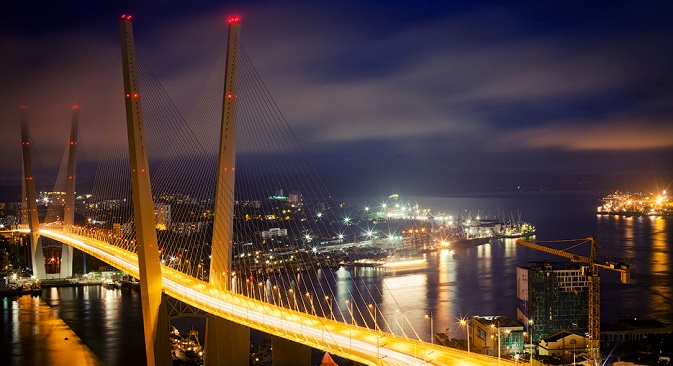The Russian example: Spreading development far and wide

The Zolotoy Rog bridge was built in Vladivostok ahead of the 2012 APEC Summit. Source: Blongman
One of the most common grievances that one hears in both Russia and India is that development is centred around the capital. The farther away a person lives from Moscow or New Delhi, the greater is his critique of the authorities for not doing enough in terms of local infrastructure. By all means, Moscow has ‘First World’ public amenities and Delhi, over the last 2 decades, has overtaken Mumbai in terms of infrastructure and overall development. It would be fair to say that living in the capital cities of Russia and India comes with privileges that are often denied to those in smaller regions of these large countries, but it’s only Moscow that seems to have woken up to this reality.
For starters, look at the approach the two countries have towards their easternmost territories. Vladimir Putin, years ago, understood the strategic value of the Russian Far East, an area that went into severe decline after the collapse of the Soviet Union. From his first term as president, massive efforts were launched to revive the economies of the region. Foreign companies were invited to Sakhalin in production sharing agreements and the island went from being a backwater near Japan, to a hub of economic activity. The most important initiative to reinvigorate the region was the decision to host the APEC Summit in Vladivostok in 2012. Russia spent more than $20 billion to host the summit and most of the money went into large infrastructure projects in the city, including two bridges that are engineering marvels. The city received a boost in international visitors during and after the summit and there are several business opportunities that became prevalent there after it was put on the international map.
Compare the Russian attitude to its far east with that of India’s virtual disinterest in its 7 northeastern states. India’s troubled northeast, by virtue of geography, is a bridge between South and Southeast Asia. The region would ideally serve as a gateway for the once-again booming economies of ASEAN into India. It’s disappointing though that no efforts are being made to develop these states and integrate them with the ASEAN region. Bangkok and Kuala Lumpur are closer to some parts of India’s northeast than Mumbai. Yet, there seems to be a lack of vision to use the low costs and location of these eastern states to gain an economic edge. Will we see a day when a major Asian summit is held in a city like Guwahati in Assam? The small city on the Brahmaputra is one of the least developed state capitals in all of India, when it should be a major hub for trade and tourism for India and Southeast Asia.
Besides hosting the APEC summit in Vladivostok, Russia chose the city of Yekaterinburg as a candidate for the 2020 World Expo. If the city gets chosen to host the expo, the region which is in the middle of the Eurasian continent will benefit enormously. For the Winter Olympics, Russia chose the city of Sochi, which is now the beneficiary of several major infrastructure projects. Sochi will also host Formula 1 racing. India, on the other hand, hosts its prestigious car race just outside Delhi. There is talk that the country may lose the race because of political reasons, but let’s put that aside for now. Delhi was also the host of the 2010 Field Hockey World Cup and the much-maligned Commonwealth Games in the same year. There are some in India who think this Delhi-centric attitude borders on arrogance and a lack of respect for other cities and regions in India.
For India to become a more developed and middle income country, it needs to follow the Russian example and put big-ticket international events in different parts of the country. These events would give a boost to the support infrastructure in the areas surrounding the host cities. A direct consequence would be more employment opportunities in these areas and an arrest in mass migration to cities like Mumbai that are already close to crumbling point.
India doesn’t look like a likely host for any major sporting competition or international summit at the moment but smaller cities and regions can be used for other important international events and meetings. Russia’s deputy prime minister (and good friend of India) Dmitry Rogozin said earlier this year that official meetings should be held in different parts of the large and diverse countries. “We are two great beautiful countries, with an endless diversity of regions,” Rogozin said in April. “I am keen to visit different cities in India, and I'd be happy to take you to our next meeting to the Far East, the Urals, Siberia and Sochi, where we will be hosting Winter Olympics next year.”
One can only hope that India takes Rogozin’s advice and also follows the example that Russia has set in terms of development spread across the country.
All rights reserved by Rossiyskaya Gazeta.
Subscribe
to our newsletter!
Get the week's best stories straight to your inbox

